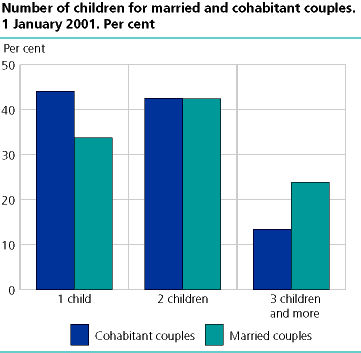Content
Published:
This is an archived release.
More couples with two children
The family of two children is ever more common among cohabitant couples with joint children. An almost equal number of cohabitant families consisted of mother, father and two underage children, as those consisting of mother, father and one child.
This according to family statistics as of 1 January 2001.
While 43 per cent of the cohabitant families consisted of two adults and two children, 44 per cent were three person families. Ten years earlier the one child family was the most common among cohabitant families with common children: 60 per cent had one child while 31 per cent had two.
The corresponding figures for married couples showed that two children were customary at the beginning of 2001. While 42 per cent of the married couples with children had two under 18, 34 per cent of them had only one child. Three children or more occurred more frequently among married than cohabitant couples. Also, the married ones more frequently had children above the age of 18.
Drawbacks and other sources of statistics
The content of Norwegian family statistics was reduced effective 1 January 1999, as a result of a growing discrepancy between the picture given by statistics and the actual family pattern in Norway. Specifically, the registration of residence regulations for students and the lacking registration of cohabitants without common children created problems. Quality assessments led to the removal of the family types mother/father with children and the one person family from the annual statistics. As a consequence, for the last three years the statistics have been less detailed than previously. "About the Statistics" can be consulted for additional information on data sources, definitions and comparisons over time.
In addition to family statistics, the children statistics give information about the family situation from the child's point of view (www.ssb.no/barn_en) and household statistics give information about household composition (www.ssb.no/hushold_en) . The results from the Population and Housing Census 2001 will present the family and household situation on 3 November 2001. Preliminary figures will be published 22 April this year, while the main release is due in the fall.
Tables:
- Table 1 Families, by type of family. 1960-2001
- Table 2 Families, by type of family. Children under 18 years of age. 1974-2001
- Table 3 Persons, by type of family. 1 January 2001
- Table 4 Families, by type of family and the number of children living at home. 1 January 2001
- Table 5 Families, by type of family and number of children living at home. Children under 18 years of age. 1 January 2001
Contact
-
Statistics Norway's Information Centre
E-mail: informasjon@ssb.no
tel.: (+47) 21 09 46 42
-
Espen Andersen
E-mail: espen.andersen@ssb.no
tel.: (+47) 92 61 00 46
-
Ane Margrete Tømmerås
E-mail: ane.tommeras@ssb.no
tel.: (+47) 91 99 29 62
-
Oppdrag befolkningsstatistikk
E-mail: befolkning@ssb.no

